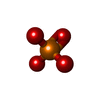Entry Database : PDB / ID : 5gs4Title Crystal structure of estrogen receptor alpha in complex with a stabilized peptide antagonist ARG-IAS-ILE-LEU-DNP-ARG-LEU-LEU-GLN Estrogen receptor Keywords / / Function / homology Function Domain/homology Component
/ / / / / / / / / / / / / / / / / / / / / / / / / / / / / / / / / / / / / / / / / / / / / / / / / / / / / / / / / / / / / / / / / / / / / / / / / / / / / / / / / / / / / / / / / / / / / / / / / / / / / / / / / / / / / / / / / / / / / / / / / / / / / / / / / / / / / / Biological species Homo sapiens (human)unidentified (others) Method / / Resolution : 2.4 Å Authors Xie, M. / Wang, T. / Li, Z.-G. Funding support Organization Grant number Country National Natural Science Foundation of China 21102007 and 21372023 the Shenzhen Science and Technology Innovation Committee
Journal : J. Med. Chem. / Year : 2017Title : Structural Basis of Inhibition of ER alpha-Coactivator Interaction by High-Affinity N-Terminus Isoaspartic Acid Tethered Helical PeptidesAuthors : Xie, M. / Zhao, H. / Liu, Q. / Zhu, Y. / Yin, F. / Liang, Y. / Jiang, Y. / Wang, D. / Hu, K. / Qin, X. / Wang, Z. / Wu, Y. / Xu, N. / Ye, X. / Wang, T. / Li, Z. History Deposition Aug 13, 2016 Deposition site / Processing site Revision 1.0 Aug 30, 2017 Provider / Type Revision 1.1 Dec 20, 2017 Group / Category / citation_authorItem _citation.country / _citation.journal_abbrev ... _citation.country / _citation.journal_abbrev / _citation.journal_id_ASTM / _citation.journal_id_CSD / _citation.journal_id_ISSN / _citation.journal_volume / _citation.page_first / _citation.page_last / _citation.pdbx_database_id_DOI / _citation.pdbx_database_id_PubMed / _citation.title / _citation.year Revision 1.2 Jul 18, 2018 Group / Category / Item Revision 1.3 Apr 9, 2025 Group Data collection / Database references ... Data collection / Database references / Derived calculations / Structure summary Category chem_comp_atom / chem_comp_bond ... chem_comp_atom / chem_comp_bond / database_2 / pdbx_entry_details / pdbx_modification_feature / struct_conn Item _database_2.pdbx_DOI / _database_2.pdbx_database_accession ... _database_2.pdbx_DOI / _database_2.pdbx_database_accession / _struct_conn.pdbx_dist_value / _struct_conn.pdbx_leaving_atom_flag / _struct_conn.ptnr1_label_atom_id / _struct_conn.ptnr2_auth_comp_id / _struct_conn.ptnr2_auth_seq_id / _struct_conn.ptnr2_label_atom_id / _struct_conn.ptnr2_label_comp_id / _struct_conn.ptnr2_label_seq_id
Show all Show less
 Yorodumi
Yorodumi Open data
Open data Basic information
Basic information Components
Components Keywords
Keywords Function and homology information
Function and homology information Homo sapiens (human)
Homo sapiens (human) X-RAY DIFFRACTION /
X-RAY DIFFRACTION /  MOLECULAR REPLACEMENT / Resolution: 2.4 Å
MOLECULAR REPLACEMENT / Resolution: 2.4 Å  Authors
Authors China, 2items
China, 2items  Citation
Citation Journal: J. Med. Chem. / Year: 2017
Journal: J. Med. Chem. / Year: 2017 Structure visualization
Structure visualization Molmil
Molmil Jmol/JSmol
Jmol/JSmol Downloads & links
Downloads & links Download
Download 5gs4.cif.gz
5gs4.cif.gz PDBx/mmCIF format
PDBx/mmCIF format pdb5gs4.ent.gz
pdb5gs4.ent.gz PDB format
PDB format 5gs4.json.gz
5gs4.json.gz PDBx/mmJSON format
PDBx/mmJSON format Other downloads
Other downloads 5gs4_validation.pdf.gz
5gs4_validation.pdf.gz wwPDB validaton report
wwPDB validaton report 5gs4_full_validation.pdf.gz
5gs4_full_validation.pdf.gz 5gs4_validation.xml.gz
5gs4_validation.xml.gz 5gs4_validation.cif.gz
5gs4_validation.cif.gz https://data.pdbj.org/pub/pdb/validation_reports/gs/5gs4
https://data.pdbj.org/pub/pdb/validation_reports/gs/5gs4 ftp://data.pdbj.org/pub/pdb/validation_reports/gs/5gs4
ftp://data.pdbj.org/pub/pdb/validation_reports/gs/5gs4 Links
Links Assembly
Assembly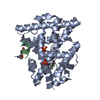
 Components
Components Homo sapiens (human) / Gene: ESR1, ESR, NR3A1 / Production host:
Homo sapiens (human) / Gene: ESR1, ESR, NR3A1 / Production host: 
 X-RAY DIFFRACTION / Number of used crystals: 1
X-RAY DIFFRACTION / Number of used crystals: 1  Sample preparation
Sample preparation ROTATING ANODE / Type: RIGAKU MICROMAX-002+ / Wavelength: 1.5418 Å
ROTATING ANODE / Type: RIGAKU MICROMAX-002+ / Wavelength: 1.5418 Å Processing
Processing MOLECULAR REPLACEMENT / Resolution: 2.4→24.298 Å / SU ML: 0.34 / Cross valid method: FREE R-VALUE / σ(F): 1.34 / Phase error: 28.52 / Stereochemistry target values: ML
MOLECULAR REPLACEMENT / Resolution: 2.4→24.298 Å / SU ML: 0.34 / Cross valid method: FREE R-VALUE / σ(F): 1.34 / Phase error: 28.52 / Stereochemistry target values: ML Movie
Movie Controller
Controller


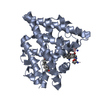


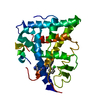

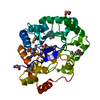
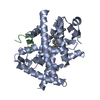

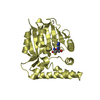

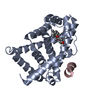
 PDBj
PDBj






